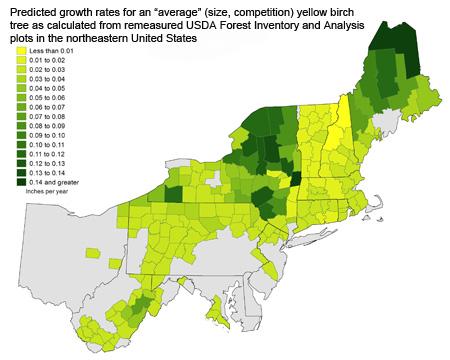Factors Influencing Productivity in the Northern Forest: A Forest Inventory Approach

Large-scale evidence from a variety of sources suggests that forests in the northern latitudes are acting as a sink for atmospheric CO2, but at the same time there is widespread concern in the Northern Forest region about the potential long-term effects of acidic deposition and associated nutrient depletion. The extent that regional-scale nutrient depletion has affected forest productivity has been uncertain because the bulk of evidence for nutrient loss and forest decline comes from small-scale research studies or regional-scale computer modeling efforts, few of which have examined tree growth responses at the stand or regional scale.
NSRC researchers conducted a study to quantify the regional-scale patterns of forest productivity in the Northeast region from ground-measured data and to assess relationships between these patterns and the factors potentially influencing forest productivity in the Northern Forest. The work was conducted using USDA Forest Service Forest Inventory and Analysis (FIA) plot data for all 13 northeastern states.
Researchers suggest solutions to the classical forest growth and yield computer models that estimate tree diameter growth rates under various scenarios. Because widely distributed tree species occur in diverse ecological conditions depending on geography, they recommend geographically-weighted modeling methods. They also propose a method for estimating forest net primary productivity (movement of carbon from atmosphere into green plants) and aboveground wood biomass accumulation using forest plot level inventory data. These data can be used to investigate what controls forest productivity, such as management, soil chemistry, climate, or tree species composition.
